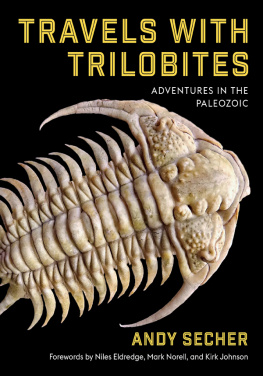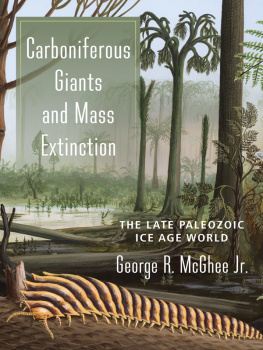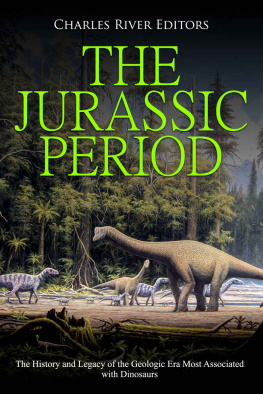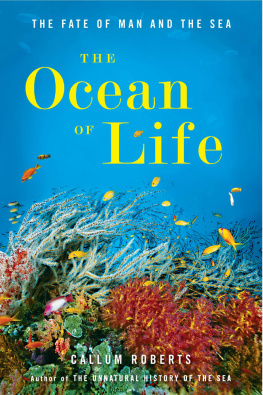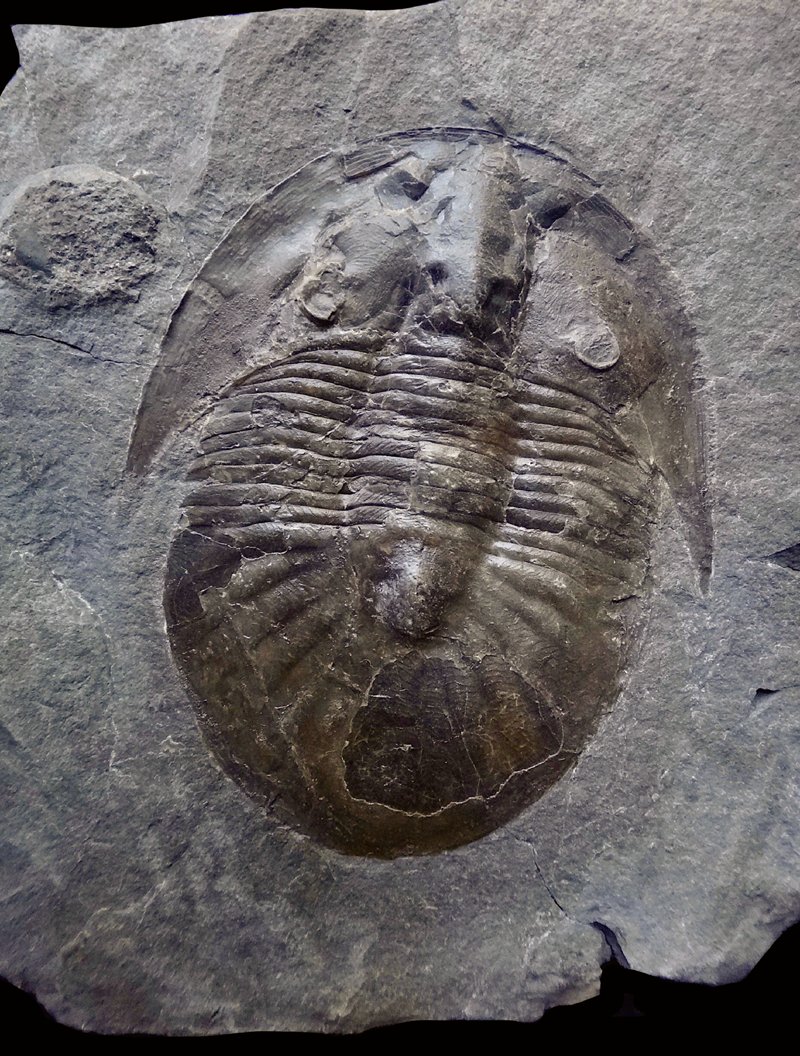Table of Contents
Travels with Trilobites
Columbia University Press
Publishers Since 1893
New York Chichester, West Sussex
cup.columbia.edu
Copyright 2022 Andy Secher
All rights reserved
EISBN 978-0-231-55386-5
Library of Congress Cataloging-in-Publication Data
Names: Secher, Andy, author.
Title: Travels with trilobites: adventures in the paleozoic / Andy Secher.
Description: New York: Columbia University Press, [2022] | Includes index.
Identifiers: LCCN 2021037496 (print) | LCCN 2021037497 (ebook) | ISBN 9780231200967 (hardback) |
ISBN 9780231553865 (ebook)
Subjects: LCSH: Trilobites. | Extinction (Biology)
Classification: LCC QE821 .S43 2022 (print) | LCC QE821 (ebook) | DDC 565/.39dc23
LC record available at https://lccn.loc.gov/2021037496
LC ebook record available at https://lccn.loc.gov/2021037497
A Columbia University Press E-book.
CUP would be pleased to hear about your reading experience with this e-book at .
Cover design: Milenda Nan Ok Lee
Cover Image: Paraceraurus Aculeatus (Eichwald, 1857)
Upper Ordovician, Caradocian; Kukruse Regional Stage; Viivikonna Formation, Alekseevka Quarry; St. Petersburg region, Russia; 10.4 cm
Title Page Image: Homotelus bromidensis (Esker, 1964)
Ordovician; Criner Hills; Carter County, Oklahoma, United States; largest trilobite: 6.2 cm
At this site, thousands of complete Homotelus specimens have been found in tightly packed alignment.
Contents Page Image: Nevadia parvoconica Fritz, 1992
Lower Cambrian; Poleta Formation; Esmeralda County, Nevada, United States; largest trilobite: 3 cm
Examples of this unusual species were uncovered in the early years of the twenty-first century. So far, no more than half-a-dozen articulated specimens have been found.
Page xi Image: Eobronteus lunatus (Billings, 1857)
Middle Ordovician; Trenton Group; Ottawa, Ontario, Canada; 7.2 cm
Scutellid trilobites are exceedingly unusual in the Trenton Group, especially when they appear as complete specimens.
This book is dedicated to everyone, everywhere, who has ever taken a moment to contemplate the wonders of trilobites. It doesnt matter if youre a casual collector who perhaps possesses a lone Elrathia kingii perched atop an office shelf or an advanced enthusiast whose free time (and spare cash) is happily spent in the pursuit and procurement of these often-elusive Paleozoic prizes. Or perhaps youre just someone interested in learning more about one of the most captivating, diverse, and strangely beautiful organisms ever to inhabit our planets primal seasthe trilobite.
I would also like to mention the support, loyalty, and guidance supplied by Jodi Summers. Throughout the years she has remained an eager and welcomed participant in many of my trilobite-related escapades to all corners of the globe. Jodis love of travel and unmatched spirit of adventure have made her an invaluable and much appreciated companion, whether it be in the heat of the Arizona desert or the late spring chill of a French mountainside.
Contents
Page xi Image: Eobronteus lunatus (Billings, 1857)
Middle Ordovician; Trenton Group; Ottawa, Ontario, Canada; 7.2 cm
Scutellid trilobites are exceedingly unusual in the Trenton Group, especially when they appear as complete specimens.
G . ARTHUR COOPER, a famous paleontologist of the mid-twentieth century, opened one of his papers on the sequence of Middle Devonian fossiliferous rocks in New York State with a paean of praise for the internal combustion engine. Less than 100 years later, that particular clever invention in large measure fuels the climate change that threatens the very existence of life on Earth. But back then it was the pure joy and exhilaration of taking your car and going pretty much wherever you wanted, whenever you wanted, to visit often remote rock outcrops and explore them for their amazing fossilized remains. No more trains, no more buggy ridesand no more long hikes across open fields and along dirt trails to get to those lakeshore, stream bank, and cliffside outcrops that nature had to offer. Efficiency replaced what we romantically are tempted to think of as the more bucolic, relaxed travel days of yore.
The pace of discovery duly quickened. And the responsible, determined acquisition of fossilsfor scientific analysis as well as the equally profound emotional and aesthetic thrill of simply seeing an exquisite form of ancient lifehas mushroomed logarithmically. Millions of fossils are now safely housed in museum collections or on display for all who wish to share in the mystery, thrill, and knowledge that fossils have to offer. Fossils are of the Earth, faithful vestiges of what life has been like in its long evolutionary journey over the past three-billion-plus years.
Increasingly, the private sector has played a determined, informed role in the ongoing exploration, collection, and meticulous cleaning (preparation) and proper storage of fossils. The assembly, care, and feeding of collections of rare, beautiful, and scientifically important specimens (I believe all specimens, no matter how beat up and ugly, are scientifically important!) is sometimes done better in dedicated private hands than in museums, with their limited resources and more diverse programmatic charges.
Best, of course, is when private collectors are affiliated with museums that aid in their fossils long-term survival, eventual scientific study, and in their public display, thus spreading their aesthetic, emotional, and scientific significance. Andy Sechers book is a rare example of the gift of beauty and knowledge of a passionate private collector who has gone to considerable effort to explain and display his dearly loved and carefully curated specimens to the world at large. His lucid text and fabulous photos take us along the space-time road of trilobite discovery. It is a succinct and fascinating retracing of the actual space-time road that trilobites themselves traveled in their evolutionary/ecological journeya journey that started at what we now define as the base of the Cambrian Period. Trilobites are the very icon of the famous Cambrian Explosion, that breathtakingly quick (only 10 million years!) burst of evolutionary diversification of complex forms of animal life still with us todayalbeit in altered form.
Extinction is a rule of life. Without it, life would not have evolved still further. Trilobites are now long gone although they survived global extinction events at the end of the Cambrian, then the Ordovician, and still later, the Upper Devonian. Already dwindling and on the ropes in the boxing ring of life, trilobites finally succumbed in that greatest mass extinction (so far!) of all at the end of the Permian Period. Trilobites frame the entire Paleozoic Era, from beginning to end. All the (nearly) 300 million years of it.

